The life cycle of a star plays a crucial role in shaping the universe. A star is a luminous ball of plasma held together by gravity and sustained by nuclear fusion reactions. They are the universe’s building blocks and play a crucial role in shaping the cosmos. There are billions of stars in our galaxy alone and countless more in the observable universe.
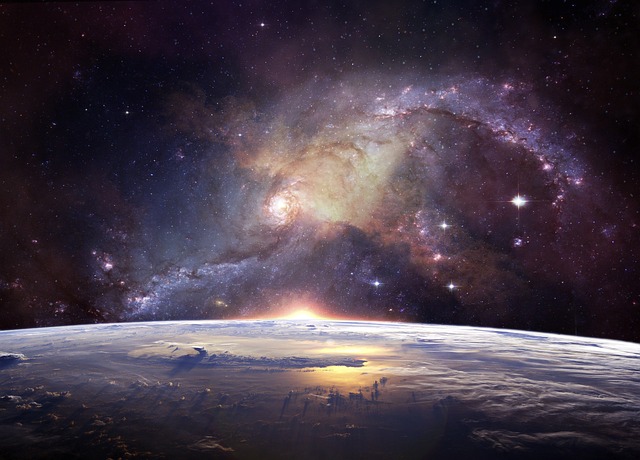
Another aspect of the beauty of stars is the variety of colors and sizes. From the faint red glow of a red dwarf to the bright blue-white light of a massive blue giant, stars come in various colors and luminosities. This diversity makes the night sky an ever-changing and constantly surprising display of beauty.
Formation of a star:
The formation of a star begins with a dense cloud of gas and dust, known as a molecular cloud. Over time, the cloud starts to collapse due to gravity, and regions of higher density within the cloud begin to form.
As the density increases, gas temperature also increases, eventually reaching the point where nuclear fusion reactions can occur. The cloud of gas and dust reaches a point where it becomes hot enough to emit light, thus marking the beginning of a Protostar.
As the protostar continues to collapse, it heats up and begins to shine more brightly. The star is now considered a main-sequence star, and it will continue to emit light for the duration of its life, sustained by nuclear fusion in its core.
Here are the Stages of the Star Life Cycle:
The life cycle of a star can be divided into several stages, each with its unique characteristics and properties. These stages are:
Nebula: A cloud of gas and dust where stars are born.
A nebula is a cloud of gas and dust in space. Various shapes and sizes of nebulae exist, ranging from massive clouds that span hundreds of light-years to small, compact clouds with only a few light-years.

Nebulae are often the birthplace of stars and play a critical role in star formation. When a nebula collapses due to gravity, regions of higher density within the cloud begin to form. These regions can eventually give rise to stars, which are born from the material in the nebula.
And also, when a star explodes in a supernova, it releases tremendous energy and disperses the star’s material into space, creating nebulae. This material can form new stars and planets and contribute to forming other nebulae.
Protostar: Beginning of Star Life Cycle
A protostar is the earliest stage of a star’s life when a dense cloud of gas and dust begins to collapse due to its gravity. The mutual gravitational attraction of the particles in the cloud causes this collapse, which pulls them together and increases the density of the cloud.

As the cloud collapses, regions of higher density form, and these regions can eventually give rise to protostars. The temperature in the cloud also increases as it collapses, finally reaching a high enough level to initiate nuclear fusion reactions. Once nuclear fusion reactions begin, the cloud becomes a main-sequence star.
T-Tauri star: Evolution of T-Tauri star
T Tauri stars are a type of young, pre-main-sequence star still in the process of contracting and growing to become a main-sequence star like the Sun. They are named after the prototype T Tauri star, which is located in the constellation Taurus.
They are characterized by their high levels of variability, both in brightness and spectral features. Circumstellar disks of gas and dust often surround them.
Main sequence star: Full bloom stage of star life cycle
Main-sequence stars are stars in their most prolonged and stable phase. They are characterized by a steady and sustained nuclear fusion in their cores, which provides the energy that drives the star’s luminosity.
The vast majority of stars in the universe, including our own Sun, are main-sequence stars. During this phase, a star’s temperature, luminosity, and size are determined by its mass. The more massive the star, the hotter, brighter, and more significant it is.
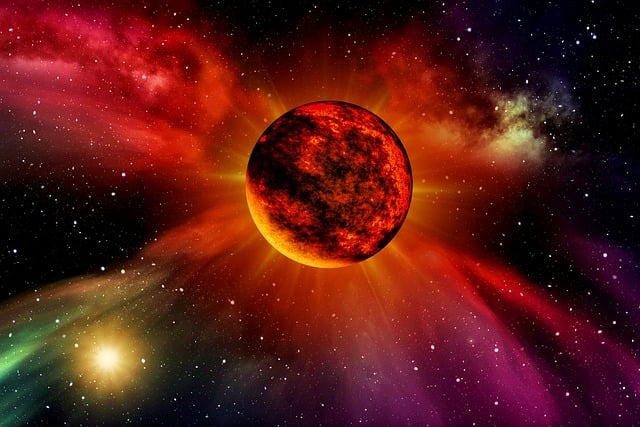
In the main-sequence phase, a star is in a state of hydrostatic equilibrium, which means that the pressure generated by the hot gas in its core is balanced by the gravitational force trying to pull the gas inward. This balance allows the star to maintain a stable size and luminosity for billions of years.
Once a main-sequence star has exhausted the hydrogen fuel in its core, it will leave the main sequence and begin to evolve into another stage, such as a red giant. Stars spend most of their life at main sequence stage.
Red Dwarf Stars: The Long and Slow Evolution of Low-Mass Stars
A red dwarf is a type of star that is smaller, cooler, and less luminous than the Sun. They are the most common type of star in the Milky Way galaxy, making up about 70% of all stars.
The surface temperatures of red dwarfs range from 2,500 to 4,000 Kelvin (4,000 to 6,700°F), which is lower compared to the Sun’s surface temperature of 5,500 Kelvin (9,932°F).
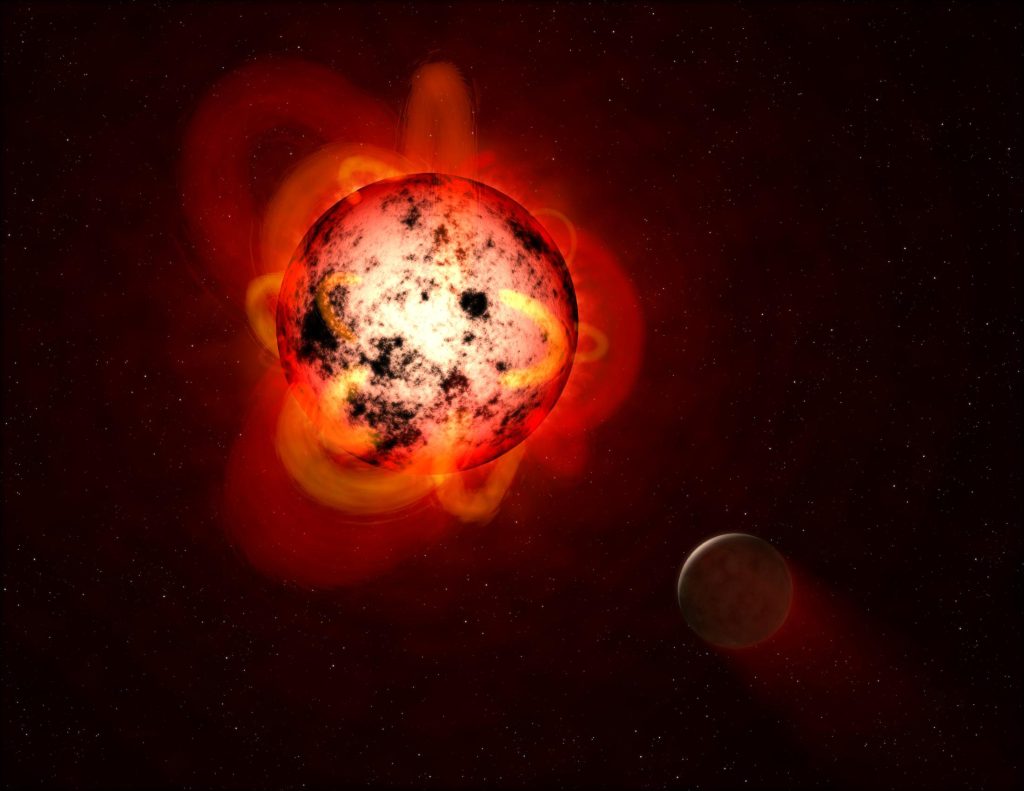
Red dwarfs are also much smaller than the Sun, with diameters typically only a fraction of the Sun’s diameter. This smaller size, combined with their low luminosity, means that red dwarfs have a much longer lifespan than larger, more luminous stars.
Scientists believe that some red dwarfs may have lifetimes of 10 trillion years or more, which is much longer than the Sun’s estimated lifetime of about 10 billion years.
Brown Dwarf: The Failed Star in the Life Cycle of a Star
A brown dwarf is a celestial object that is intermediate in size between a planet and a star. People sometimes call Brown Dwarfs ‘failed stars’ because they are not massive enough to sustain the nuclear fusion reactions that power stars.
Brown dwarfs have masses that range from about 13 to 80 times the mass of Jupiter, the giant planet in the solar system.
Red giant stars: Intermediate stage of star’s life cycle
Red Giant stars are large, cool stars later in their lives. Their red color and large size resulting from their expanded outer layers give them the name “red giants.”
Red Giants formed from stars once similar in size to the Sun. As these stars age, they run out of fuel in their cores and expand. The transfer of energy from the center to the outer layers causes the outer layers to heat up and expand, resulting in this expansion.
As the star expands, its surface temperature decreases, and its surface becomes cooler and redder in color.
Every star evolves in the same path upto red giant phase and its later phases depend on mass of the star. The lower mass star ends their life as white dwarf and the high mass stars end their life as black hole or neutron star.
Evolution of low-mass stars:
Planetary Nebula: The Dazzling Result of a Star’s Life Cycle
When a low-mass star, like our Sun, reaches the end of its life and begins to expel its outer layers into space, it forms a type of emission nebula known as a planetary nebula.
The name “planetary nebula” is a bit of a misnomer, as these objects have nothing to do with planets. They were named as such because of their round, planet-like appearance when viewed through early telescopes.
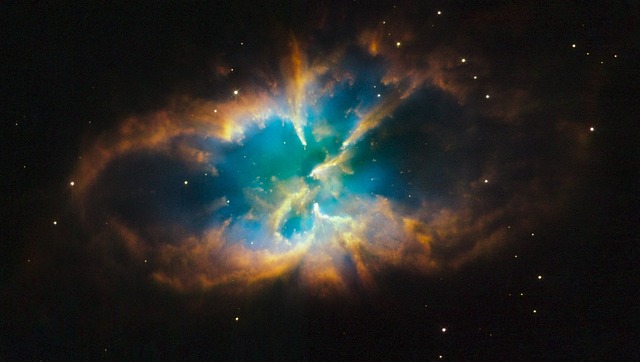
The ejected material from the star forms a glowing cloud of gas visible in the night sky. The ultraviolet radiation from the star’s hot inner core heats the gas, causing it to emit light and create the bright, colorful appearance characteristic of planetary nebulae.
The star’s inner core, known as a white dwarf, is boiling and can continue to shine for millions of years after the ejection of the outer layers.
Planetary nebulae play an essential role in star life cycle and matter’s life cycle. As the gas and dust from the nebula expand into space, they can eventually collapse to form new generations of stars and planetary systems.
White dwarf: A dense white Ball | Fate of smaller stars
White dwarfs have a mass similar to the Sun but a size similar to Earth’s. This high-density results from the star’s core collapsing and undergoing electron degeneracy pressure, which prevents the core from collapsing further.
A white dwarf is the remnant of a star that has exhausted the nuclear fuel in its core and has shed its outer layers. It is the final stage of evolution for stars like our Sun. White dwarfs are extremely dense and have a characteristic white color, hence the name “white dwarf.
The high density of a white dwarf is due to its small size and the fact that the pressure from nuclear reactions no longer supports its matter. Instead, the matter in a white dwarf is held together by electron degeneracy pressure, resulting from the Pauli exclusion principle.
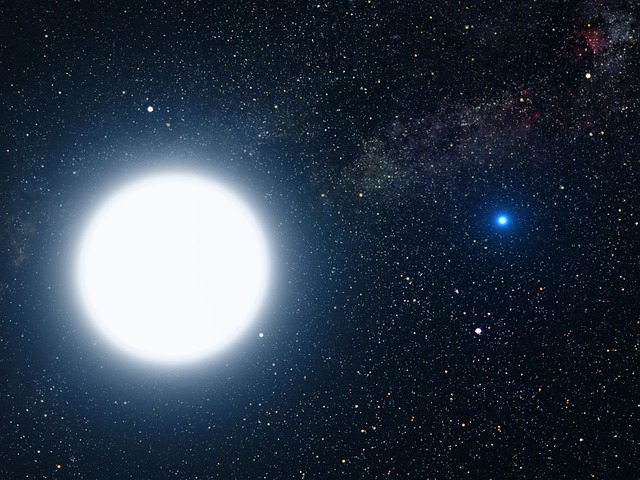
White dwarfs no longer have a source of energy to counteract the gravitational pull, so they cool down and fade away over billions of years.
White dwarfs are of great interest to scientists because they provide essential information about the life cycle of stars and the universe’s history. For example, studying white dwarfs has allowed astronomers to determine the age of some of the oldest stars in the Milky Way.
Scientists can also use white dwarfs to study the properties of matter at extreme densities, which are impossible to recreate in laboratory conditions on Earth.
Black dwarf: Demise of Low mass stars
Black dwarfs are the final evolutionary stage of low-mass stars, representing the end of a stars life. The process of forming a black dwarf occurs when a white dwarf, which is the dense leftover of a red giant star, has cooled down to the extent where it no longer emits significant heat or light.
White dwarfs are extremely hot when they first form, with surface temperatures of tens of thousands of degrees Kelvin. However, over time, they cool down as they radiatively lose energy and eventually become black dwarfs.
Most white dwarfs take billions of years to cool down, which prolongs the cooling process. Therefore, it is expected that significant numbers of black dwarfs will not be found until several billion years into the future.
Because black dwarfs are the final evolutionary stage of low-mass stars, they play an essential role in the evolution of galaxies. The accumulation of black dwarfs over time will affect the overall evolution of galaxies. It may eventually lead to the extinction of some star-forming regions.
Evolution of high-mass stars:
Supernova: Explosive End of a Star’s Life Cycle
A supernova is a powerful and luminous explosion that occurs when a star has exhausted its nuclear fuel and can no longer support its weight. Supernovae are among the most spectacular events in the universe and play a crucial role in shaping the cosmos.
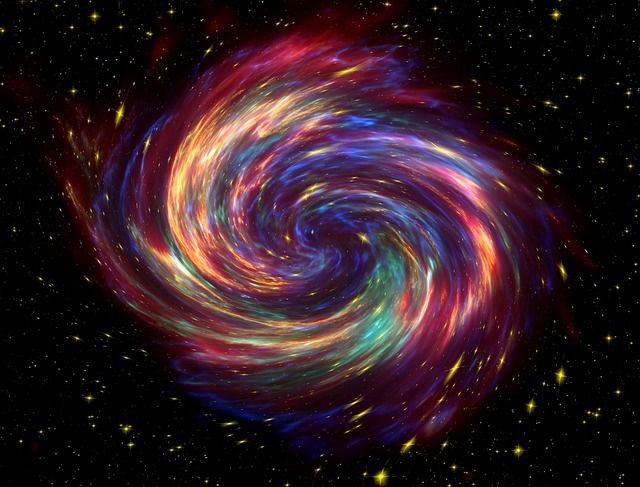
There are two main types of supernovae: Type I and Type II.
Type1 supernova:
Type I supernovae occur in binary star systems, where a white dwarf star orbits a companion star. The white dwarf accretes material from the companion star. Once it has reached a critical mass, it undergoes a thermonuclear explosion.
Type I supernovae are characterized by the absence of hydrogen in their spectra. They are relatively faint compared to Type II supernovae.
Type2 supernova:
On the other hand, Type II supernovae occur in massive stars that have exhausted their nuclear fuel and can no longer support their weight. When a large star runs out of fuel, its core collapses, and the release of gravitational potential energy heats and compresses the material in the center.
This process initiates a chain reaction of nuclear fusion that produces an explosion that blows off the star’s outer layers. Type II supernovae are characterized by the presence of hydrogen in their spectra. They are much brighter and more energetic than Type I supernovae.
The explosion of a supernova is so powerful that it can outshine an entire galaxy for a short period. Scientists utilize supernovae as probe to study the properties of stars and galaxies, as well as to determine distances, as visible light emitted by these phenomena could have observed from billions of light-years away.
Neutron star
A neutron star is the extremely dense and compact remnant of a massive star that has undergone a supernova explosion. Subatomic particles with no electrical charge, called neutrons, compose almost the entirety of neutron stars.
Neutron stars are incredibly dense, with sizes of only 10-20 kilometers and masses comparable to the Sun. This high-density results in powerful gravitational forces, which can deform the shape of a neutron star and cause it to emit strong gravitational waves.
Neutron stars are also scorching, with surface temperatures of millions of degrees Kelvin. They are also incredibly fast-spinning, with only a few milliseconds of rotational periods.
Certain neutron stars emitting intense X-rays and gamma rays, which scientists believe to be the source of some of the most luminous and energetic phenomena in the universe, such as gamma-ray bursts and pulsars.
Black hole: The most mysterious End to Star’s Life Cycle
Black hole is the end of a star life cycle. It is formed from the remnants of massive stars. When such a star runs out of fuel, it can collapse into a very dense object known as a neutron star or a black hole, depending on the remnant’s mass. On the other hand, black holes have no size limit and can be much more massive than neutron stars.
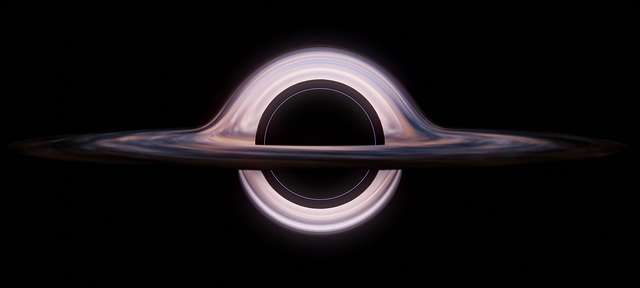
There are three main types of black holes: stellar black holes, intermediate black holes, and supermassive black holes.
Stellar black holes are the remnants of massive stars. It masses range from a few to several tens of times the mass of the Sun.
Intermediate black holes have masses between stellar black holes and supermassive black holes. Scientists believe that intermediate black holes play an essential role in the formation and evolution of galaxies.
Supermassive black holes are located at the centers of most galaxies. They have masses ranging from millions to billions of times that of the Sun.
Elements formed during the Life Cycle of a Star:
The formation of different elements in a star’s life cycle results from nuclear fusion. Which takes place in the star’s core. Here’s a general overview of how the elements formed:
Hydrogen
During the Main Sequence stage, a star fuses the most abundant element, hydrogen, into helium. This process releases tremendous energy, which keeps the star shining brightly.
Helium:
When two hydrogen atoms have fused, they form a helium atom. This reaction releases tremendous energy and is the primary energy source for Main Sequence stars.
Carbon:
When the hydrogen supply in its core has exhausted, a star forms carbon. Once the temperature and pressure in the core have increased. A triple-alpha process can fuse helium into carbon.
The Triple-Alpha process occurs in stars with a mass greater than 1.5 times that of the Sun. It results in the production of carbon. which will eventually become the seed for the formation of even heavier elements.
Oxygen:
When a star has exhausted the hydrogen supply in its core, it generates oxygen by fusing carbon and helium.
Heavy Elements:
It is believed that heavier elements has formed in the later stages of a star’s life cycle. Once the star has exhausted the helium in its core, the core will continue to contract and heat up. Further, producing even heavier elements through a process called nuclear fusion. Stars with a mass greater than eight times that of the Sun can produce elements even heavier than iron.
Conclusion:
The star life cycle is a complex process that can last for billions of years. It starts with forming a cloud of gas and dust known as a nebula. Gravity causes the material in the nebula to collapse and form a protostar, which eventually becomes a main-sequence star. During its main-sequence phase, a star converts hydrogen into helium, producing energy and light.
After its main-sequence phase, the star’s internal structure changes, evolving into a red giant, then a white dwarf. Low-mass stars will eventually cool and fade into a black dwarf. In contrast, high-mass stars may experience a supernova explosion, leaving behind a neutron star or black hole.
Throughout its life cycle, a star can influence the formation of planets and the evolution of galaxies. Understanding the life cycle of stars is crucial for understanding the universe and the evolution of the cosmos. For more articles visit 21hashtags
